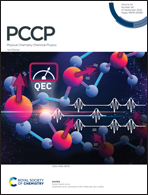Benchmark ab initio potential energy surface mapping of the F + CH3NH2 reaction
Abstract
This electronic structure study reveals four exothermic and two endothermic reaction pathways of the F + CH3NH2 system: the barrierless hydrogen abstraction from the methyl/amino group (HF + CH2NH2/CH3NH), amino/methyl substitution (NH2 + CH3F and CH3 + NH2F) and hydrogen substitution from the two functional groups (H + CH2FNH2/CH3NHF). The benchmark classical and adiabatic energies are obtained using a high-accuracy composite ab initio approach, where the gold-standard explicitly-correlated coupled cluster method (CCSD(T)-F12b) is applied with the correlation-consistent polarized valence quintuple-zeta F12 basis set (cc-pV5Z-F12) and further additive energy contributions. Considering indispensable post-(T) correlation, core correlation, scalar relativistic, spin–orbit and harmonic zero-point energy corrections, the obtained global minimum of the potential energy surface is the post-reaction CH2NH2⋯HF complex in the product channel. Although each substitution pathway has a high barrier, the energies of amino-substitution and methyl-hydrogen-substitution products are below the energy of the reactants, as well as the submerged-barrier hydrogen-abstraction pathways.



 Please wait while we load your content...
Please wait while we load your content...